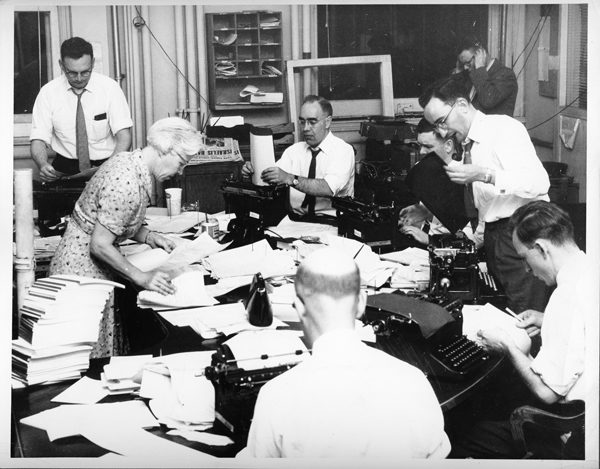Endangered species
In an era when the Toronto Sun misspells "Correction" in a correction column, is there any hope for a revival of good copyediting?
It’s 1972, and the scent of cigarette smoke and stewed coffee acts as a backdrop to the clack clack ching of manual typewriters inThe Globe and Mailnewsroom. Men’s voices fill the room—asking questions, bouncing ideas off one another, laughing at crude jokes. About 15 men in ties and white shirts are seated around a large, horseshoe-shaped desk—the “rim”—situated in the middle of the room. Inside the horseshoe sit a slot editor, an assistant slot editor, and four news editors. Off to the side, there is a smaller rim for the Report on Business section.
Both rims are cluttered with pens, paper, coffee cups, ashtrays, style guides, dictionaries—and, of course, copy. Once a reporter has written a story, it goes to a news, or back desk, editor, then a traffic handler, who looks it over before assigning it to one of the rim men. He pores over it, looking for clarity, factual and grammatical errors, and spelling mistakes before sending it along to the copy chief, who gives it a once-over. The senior news editor will give it a final read once it’s in proof. In total, the copy is seen by at least six people on its journey from notepad to newspaper.
Today, a story may be vetted by three sets of eyes, some of them belonging to staff at out-of-house “copy mills.” It’s not uncommon for online stories to be posted after being reviewed by just one person. Errors that would have had the old rim denizens squirming have become more and more common. In late 2012, the Toronto Sun misspelled “correrction” in correction note, and early this year, a headline described owner Quebecor Media Inc.’s CEO and president as “influencial.” Also, last year the Ottawa Citizen stated that the Titanic sank in 2012, and in a restaurant review The Hamilton Spectatormixed up the name of a restaurant, Sarcoa, with sarcoma.
Meanwhile, last September, the Globe published the headline “Egypt Siezes the Day at UN” on its front page. As Greg O’Neill, one of the longest-serving copy editors at the Globe, explains: “Naturally, when you take away a safe system, you’re going to have an increase in errors. We try, everyone just tries to be more intense and focused so some of those errors don’t happen, but they do.”
Some blame outsourcing for the decline in copyediting standards. Paul Morse, president of the Southern Ontario Newsmedia Guild, belongs to this group. “It makes no sense to take part of the process that makes the product as best as it possibly can be and try to send it out to some lower-wage, boiler-room kind of place,” he says. “Readers are content consumers; they notice that stuff. If we blow it in a story, when an obvious mistake or even a not-so-obvious mistake happens, readers let you know. Copy mills are not something that we want. It just drags down the overall quality of the journalism that we believe in.”
But in reality, things are more complicated.
Greg O’Neill’s manner embodies what I imagine when I think of an old-school newspaper guy. He’s outspoken, with a take-no-shit attitude, his voice gruff from years of smoking. With his shoulder-length, greying brown hair and grey handlebar mustache, he projects an air of cool nonchalance with a side of don’t mess with me. He takes off his leather jacket to reveal a white button-down shirt with no tie, unlike the norm at the Globe when he joined the copy desk in 1978.
Back then, the newsroom was louder; in those computerless days, copy editors relied more on one another to get things right. While editor-reporter exchanges could escalate into a fist through a wall, O’Neill describes typical conversations about usage or style as “determined discussions.”
“When I first started, all you did was come in and copyedit; they had a separate layout desk,” Beverley Spencer, a Globe copy editor from 2002 to 2009, recalls. “The first move was merging the copy desk and the layout desk. One of the disadvantages was that it gave us less time to work on the copyediting itself. You caught the big stuff and you had enough time to check spelling, tidy up grammar, and tighten up the sentences, but there was increasingly less time to really look at the story and go to the reporter and say, ‘Is this what you really meant when you said this?’”
Eric McGuinness, who spent 33 years at the Spectator, agrees that the biggest change in terms of quality occurred when copy editors started taking on pagination roles. “There was a great emphasis on production, getting the technical part and the layout right at the expense of grammar, accuracy, and content quality,” he says. McGuinness, who took a buyout from the Spec in 2010, now works four days a week at Postmedia’s editorial hub in Hamilton. Ironically, copy editors and paginators there stick to their different tasks.
Recently, copy editors have taken on even more roles. Angela Hickman, who worked as a part-time copy editor and backup A1 editor at the National Postuntil this February, became accustomed to having multiple responsibilities. Not only did she edit and write display; she was also responsible for the layout and a degree of art direction.
At the Citizen, the title “copy editor” is more a technicality in the contract than a reality. As of last August, about 95 percent of the paper is edited and laid out in Hamilton. The exception is the local content, which includes the national section, because of Ottawa’s national capital status, and pages one and two. Editor-in-chief and publisher Gerry Nott says that outsourcing has allowed in-house employees to focus purely on creating local content and has removed the “burden of production” from the newsroom—although he admits that the move was partially done to save money.
As Steve Ladurantaye, the Globe’s media reporter, says, “Papers are losing a shitload of money. By cutting today, they can publish tomorrow.”
It’s hardly news that the industry in North America has been shaken by a series of developments, starting with the hollowing out of classified ad sections due to the advent of Craigslist and its imitators. Then sliding circulation translated to lower ad rates. The recession that hit in 2008 meant further losses. Papers have responded by cutting employees, and the hit lists frequently include a disproportionate number of desk staff. “No other job classification has suffered so many losses as the news business downsizes,” Merrill Perlman wrote in a commentary for CNN last year. Perlman, who spent 25 years at The New York Times, added, “Given the choice between having to give up reporters or give up copy editors, reporters will win nearly every time because they provide ‘content.’”
And so the “burden of production” now increasingly falls on remote editorial outlets.Pagemasters North America, for example, based in downtown Toronto, promises to deliver pages “to your newspaper’s specifications and high quality standards at a fraction of your current production costs.” It offers copyediting, headline writing, layout, and page design services. Started in 1991 by two Australian journalists, it has expanded to New Zealand, England, and, in 2010, Canada. Here, the company is a subsidiary of The Canadian Press, which is partly owned by Torstar Corporation and the Globe and Mail Inc. Not surprisingly, the Globe and Toronto Star are both clients, along with a number of smaller papers.
Overlooking King Street East, the Pagemasters newsroom’s only resemblance to the glory days of the desk is its circa-1980s furniture. Clusters of desks are set up so the copy editors face one another. The room is a large, airy space, and the banks of windows looking down upon Toronto’s King and Victoria streets keep it bright. Many of the copy editors are in their mid- to late 20s. A handful of older copy editors once worked at dailies and have now landed here post-buyout, often as part-timers.
Brian Christmas, a 61-year-old former Globe copy editor, is one. He currently works at Pagemasters three days a week and makes considerably less than what he earned before taking a buyout in 2009. Though he considers this “pocket money,” he’s at the high end of the wage scale: the rate for agate editors starts at $16.83 an hour, while other copy editors’ base is $20.19. In early March, the Star announced announced it was laying off 32 editorial staff, including copy editors, saying it was sending work to Pagemasters instead. A top-level copy editor at the Star makes $87,000; the same person at Pagemasters would earn $48,000.
The pay may be sharply different, but Christmas says that the workload is the same, about eight stories per six-hour shift. But this time he’s remote from the Globe’s newsroom, even though he primarily works on its ROB section, just as he did four years ago. The arrangement has left him feeling like a second-class citizen at times. “Sometimes a good banter with a reporter gets the juices flowing,” he says.
Some reporters miss the interaction, too. Ladurantaye says he values the human contact that happens between reporters and editors, something that doesn’t exist when stories are zapped over the internet from in-house editors to remote copy editors. Before, he says, “You could have face-to-face conversations; there was accountability that if a copy editor changed your story and made a mistake, there was somebody you could talk to about it.
Postmedia Editorial Services in Hamilton is located in a nondescript one-storey building, sandwiched between two fast food restaurants in the gritty west end of town. The workroom has rows of desks and PCs—“It’s what you expect for a page factory,” says one employee. A free, brew-it-yourself Bunn coffee maker and a 50-cents-a-cup Tassimo brewer fortify the 170 employees, particularly those working the late shift.
“By delivering high-quality finished pages at a reasonable cost, Postmedia Editorial Services frees journalists from production roles that detract from their ability to focus on their core competencies in content creation,” is the service’s pledge. Some editors spend their eight-hour shifts jumping back and forth between papers, editing a couple dozen stories, while others focus on entire pages for one paper. An experienced staffer here can make about $35 an hour. Above the copy editors are the quality-control editors, or “QCs” for short—the contemporary version of the slot. There is a QC and assistant QC for each paper, and it’s their job to control the workflow and ultimately sign off on the copy.
McGuinness, who’s been at the Hamilton hub since February 2012, now works four days a week, primarily on Citizen copy. He says there is a lot of back and forth between Hamilton and the other papers; he adds that because most of the copy editors previously worked at one of Postmedia’s papers, there is usually someone to answer local geography or style questions. In his time there, he has only seen a few departures, but a lot of hiring. He doesn’t blame outsourcing for a decline in quality, but, like most, does not think the desk process is what it once was. “To some extent, it’s asking fewer people to do more work,” he says. “The amount of time devoted to a story has been reduced. I think we used to have the luxury of more people and more time.”
More training, too.
David Climenhaga is a former copy editor and reporter for the Globe and the Calgary Herald. He gets quite heated when discussing the “dirty little secret about the newspaper business in the last 20 years.” “They’ve always talked a great line about training, always talked a great line about quality, but never gave a damn about it from pay cheque to pay cheque,” he says. “All they cared about was trimming the bottom line.
At the Globe, O’Neill once trained the new copy editors when he was copy chief. One of the practices he’d warn against was what he calls “robot editing.” “There are rules that we have to follow, but you have to use your good intellectual judgement to follow those rules. When you don’t, you’re a robot; and you’re not a good copy editor.”
The combination of highly experienced senior editors with time to help out younger colleagues, and more time in general to focus on editing, is a fond memory for people who worked in the industry in the late ’70s and ’80s.
These days, just giving the story a rushed check to make sure there is nothing terribly wrong is sometimes all there is time for. When Angela Hickman moved from The Gazette to the Post in 2011, she was the greenest person on the desk; in under a year she was training the new copy editors. “Because there’s no job security, it’s really difficult to attract anybody with any experience, so we end up hiring a lot of people who have never copyedited before,” she says. “The most experience they’ve ever had at a newspaper is maybe a six-week reporting internship.”
Although he doesn’t think that the desk is dead, Ladurantaye regards it as an “endangered species.” It’s not that copy editors don’t care. Sue Grimbly, who left the Globe last September after working there off and on for 20 years, says forcefully: “Everyone is doing their level best to make sure it’s just as smart as it always was. They care bitterly; they don’t want to see mistakes get in.” Christmas is equally passionate about the craft: “It serves a vital function. Not just as a guardian of the language, but also to push back against reporters, urge them to dig a little deeper. I think that role, if it dies away, will be sadly missed.” Perhaps the future of copyediting is the editorial hub. Patti Tasko, the managing editor of Pagemasters’ Canadian outpost, regards it as an outlet where copy editors can shine (albeit at bargain-basement wages).“[Copy editors] are going to be in a position of authority because it’s all we do,” she says. “We want the best skilled people to rise to the top.”
Hickman was fully aware that her position as a Post copy editor was on its way out. Because she now works for the Financial Post section, she’ll get to keep an in-house job after the Post moves much of its copyediting to Hamilton this spring. She’s heard that as much as 25 percent of the papers’ pages will stay in-house, but doesn’t know if that will actually be the case.
“You get the sense that it’s a dying art,” says Hickman, audibly sad. Although not all reporters value copyediting, senior editors do. Many started as copy editors and want to keep the process in-house. She remembers the catches she’s made. “Sometimes you end up with great writers, but they spell someone’s name wrong or a different way every single appearance in the story. It’s their main character and there’s seven different spellings of their name. Even if the story is great, no one reading it is going to be like, ‘This is a great story.’ They’re going to be like, ‘This guy doesn’t even know what he’s talking about; he can’t even spell.’
O’Neill remains optimistic. He recalls a day late last year when his shift ended and he was totally bushed; he looked at the co-worker next to him, who was beat, too. “It still shows that there’s a value in my job,” he says. “If two people are that exhausted doing their work, then we do have a use and a future.”
by Gin Sexsmith
Gin was the Chief Copy Editor for the Summer 2013 issue of the Ryerson Review of Journalism.














































